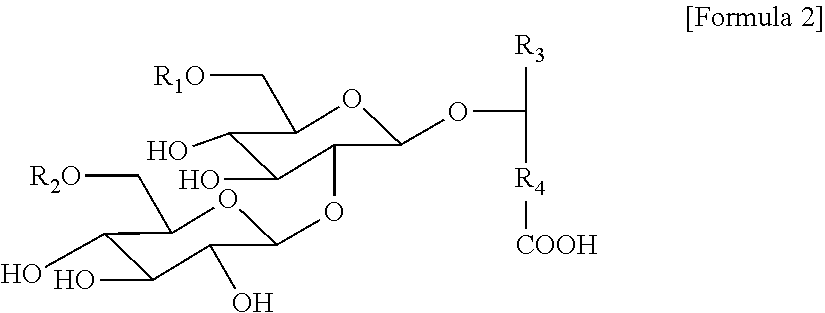Method for producing sophorose lipid
a technology of sophorose lipids and culture conditions, which is applied in the field of sophorose lipids, can solve the problems of insufficient knowledge of the culture conditions of producing solid sophorose lipids, inability to apply industrially, and inability to teach the composition ratio of the produced solid sophorose lipids, etc., to achieve high antibacterial and/or antifungal activity, high degree of saturation of fatty acid side chains, and the effect of high antibacterial and antifungal
- Summary
- Abstract
- Description
- Claims
- Application Information
AI Technical Summary
Benefits of technology
Problems solved by technology
Method used
Image
Examples
example 1
[0083]As a seed medium, 50 ml of a liquid medium (0.1% potassium dihydrogen phosphate, 0.5% manganese sulfate heptahydrate, 0.01% iron (II) chloride, 0.01% sodium chloride, 0.4% yeast extract, 10% glucose and 10% rapeseed oil, pH 4.5) was poured into a 500 ml shaking (Sakaguchi) flask. As a main medium, 3 L of a liquid medium (0.1% potassium dihydrogen phosphate, 0.5% manganese sulfate heptahydrate, 0.01% iron (II) chloride, 0.01% sodium chloride, 0.4% yeast extract, 10% glucose and Esterpal-M produced from palm oil (molar ratio (methyl palmitate:methyl stearate)=7:3, Miyoshi Oil & Fat Co., Ltd.), pH 4.5) was poured into a 5 L mini jar fermenter (B.E. MARUBISHI Co., Ltd.). These media were sterilized by steam at 121° C. for 20 minutes. One platinum loop of Candida bombicola ATCC 22214 was inoculated to the seed medium and cultured with shaking at 30° C. for one day. The entire seed culture was inoculated to the main medium and cultured at 30° C., 450 rpm and 0.3 vvm for seven days. ...
example 2
[0091]The entire culture obtained in Example 1 was heated to 80° C., whereby an oily substance (about 300 g) was precipitated. The oily substance was rinsed with an equal volume of hexane to remove the unused oil and fat and then extracted with an equivalent volume of ethyl acetate. Thus, an ethyl acetate solution of sophorose lipids was obtained. Ethyl acetate was distilled off by vacuum concentration and then 1.5 L of water was added to the residue. The pH of the resulting mixture was adjusted to 6.5 and the mixture was cooled from room temperature to 4° C. for cooling crystallization. The precipitated crystals were collected by filtration and dried, whereby solid sophorose lipids (18 g) were obtained. The sophorose lipids were analyzed under the HPLC conditions described in Example 1. The results revealed that the mole percent of lactonic sophorose lipids was 100%, that the mole percent of the diacetyl lactone form based on the total moles of lactonic sophorose lipids was 96%, an...
example 3
[0092]The same culture procedures as described in Example 1 were performed, except that the aeration condition during the main culture was changed to 0.2 vvm. The culture after completion of the culture process was analyzed under the HPLC conditions described in Example 1. The results revealed that acidic sophorose lipids were not detected at all and the mole percent of lactonic sophorose lipids was 100%. The mole percent of the diacetyl lactone form based on the total moles of lactonic sophorose lipids was 89%, and the mole percent of saturated fatty acid side chains based on the total moles of fatty acid side chains was 86%.
[0093]The temporal change of the dissolved oxygen saturation level during the culture process is illustrated in FIG. 1. The dissolved oxygen saturation level reached 0% one day after culture initiation and thereafter did not rise.
PUM
| Property | Measurement | Unit |
|---|---|---|
| mole percent | aaaaa | aaaaa |
| mole percent | aaaaa | aaaaa |
| mole percent | aaaaa | aaaaa |
Abstract
Description
Claims
Application Information
 Login to View More
Login to View More - R&D
- Intellectual Property
- Life Sciences
- Materials
- Tech Scout
- Unparalleled Data Quality
- Higher Quality Content
- 60% Fewer Hallucinations
Browse by: Latest US Patents, China's latest patents, Technical Efficacy Thesaurus, Application Domain, Technology Topic, Popular Technical Reports.
© 2025 PatSnap. All rights reserved.Legal|Privacy policy|Modern Slavery Act Transparency Statement|Sitemap|About US| Contact US: help@patsnap.com



